Introduction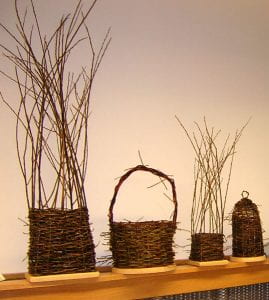
Benefits
Eco Arts
Activities
Resources
Gallery
Toolkit
Project Acknowledgments
Introduction
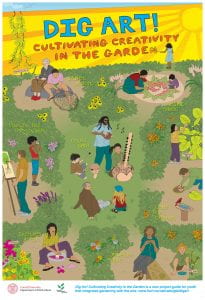 What:
What:
Dig Art! Cultivating Creativity in the Garden is a new project guide for educators working with youth that integrates gardening with the arts. The arts activities in this guide will help to teach ecological literacy and inspire new enthusiasm for garden-based learning. Dig Art! activities support youth to creatively express themselves and their garden experiences through gourd art, printmaking, time-lapse photography, and other creative projects.
For many young people, creating art is a natural form of self-expression and is a central source of fulfillment, relaxation, and creativity in their lives. That is why encouraging children and youth to integrate endeavors in the arts with the outdoors is the central aim of Dig Art!
How:
Dig Art! activities are diverse and adaptable and thus can take place over a time-span of one hour, one week, or one month. There are short, small-scale activities and larger, long-term projects.
Where:
Dig Art! activities can take place indoors and outdoors, anywhere and everywhere! They can take place in a schoolyard or school garden, in a community garden, in a backyard garden, in a tiny flower patch, in the classroom, at day camps, summer camps, after-school programs, 4-H programs and more.
Benefits
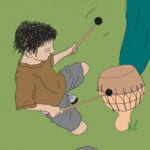 Speaks to a diversity of learners
Speaks to a diversity of learners
Art activities create opportunities for different learners to approach subject matters in a variety of ways, thus providing avenues into the garden-based content for a diversity of young people.
Makes learning meaningful
Incorporating the arts into garden-based learning programs helps learning to become meaningful. Art enhances the learning process through hands-on experiences that foster critical thinking and creative expression.
Develops reflective learners
Gardens are living laboratories for environmental and scientific explorations. Art is an excellent means through which to explore and express ideas; it helps learners to engage with important ideas and questions and to be reflective learners.
Creates an interdisciplinary and holistic curriculum
The more an educational program can make linkages across disciplines, the more holistic the curriculum will be. The scientific inquiry generated from garden-based learning is consistent with arts education because it encourages students to question concepts and make connections.
Makes learning visible
Art makes the outcomes of garden-based learning content visible and thus can be an important tool used for program evaluation, assessment, and students sharing their learning with others.
Eco Arts
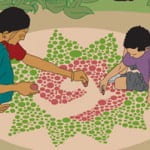 See the following page, Safety Tips, for more information on safety, materials to avoid and recipes for natural homemade dyes and paints.
See the following page, Safety Tips, for more information on safety, materials to avoid and recipes for natural homemade dyes and paints.
Beautifying a garden space with mosaics, murals and sculptures are all great ways to create a connection between gardening and the arts, but as you create art for your garden it is important to make sure that it is made with non-toxic materials. You wouldn’t want the toxic elements from an art project to harm the natural environment in your garden that you worked so hard to make beautiful! After reading through this section, we hope that you’ll think twice about which paint you buy to make those beautiful signs in your vegetable garden.
Despite being wonderfully engaging and fulfilling, arts activities such as painting and sculpting can be hazardous for your health and the health of the natural environment. You might not have realized that many of the ingredients in paints, glues, glazes, and other arts and crafts materials are toxic. Exposure to these hazardous products by children and youth can occur through ingestion, inhalation, or absorption through the skin. The group Healthy Child, Healthy World reports that exposure to the toxic chemicals found in some art supplies can result in problems such as headaches, nausea, burns, breathing problems, lung and kidney damage, and even cancer.
Activities
Adapt these activities to the age, interest, and skill levels of your group. All activities are in printable PDF format. Click on the topic heading for background information and connections to NYS Learning Standards.
Mosaic Making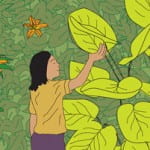
Seed Mosaic Planter(pdf)
Stepping Stones(pdf)
Flower Mandala(pdf)
Printmaking
Leaf Print Casting(pdf)
Painted Leaf Prints(pdf)
Chlorophyll Prints(pdf)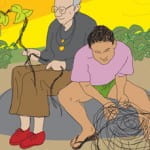
Gourd Crafting
Grow a Gourd Birdhouse(pdf)
Shekere Shaker(pdf)
Gourd Painting(pdf)
Natural Fibers and Dyes
Basket Weaving(pdf)
Seed Jewelry Making(pdf)
Clothes Dyeing(pdf)
Photography in the Garden
Human Camera(pdf)
Time Lapse Video(pdf)
Grass Photographs(pdf)
Visual Art and Performance
Drawing in the Garden Part 1 | Part 2 | Part 3 | Part 4 (pdf)
Garden Songs (pdf)
Painting in the Garden(pdf)
Public Art
Grow an Art Garden
Beginners Guide to Garden Art(pdf)
Plant a Rainbow(pdf)
Plants Used in Art Projects (pdf)
“Garden arts, theater, music, and dance are not merely interesting spectacles for entertaining community. They are the very stuff that a community’s culture is made of. The best children’s gardening programs don’t try to fit “the arts” into a pre-established agenda, but instead cultivate project ideas, garden designs, and horticultural activities based on the natural creative instincts and artistic passions of the children themselves, young and old.”~From Digging Deeper: Integrating Youth Gardens into Schools and Communities by Joseph Kiefer and Martin Kemple
Resources
 Visit the Dig Art! Resources Page for inspiration and additional information about:
Visit the Dig Art! Resources Page for inspiration and additional information about:
-Additional Activities and Curricula
-Garden Arts Inspiration
-Curriculum Integration
-Gardens, Music, and Drama
-Environmentally-Friendly Art
Gallery
See more photos on Flickr or the Art of Horticulture Gallery.
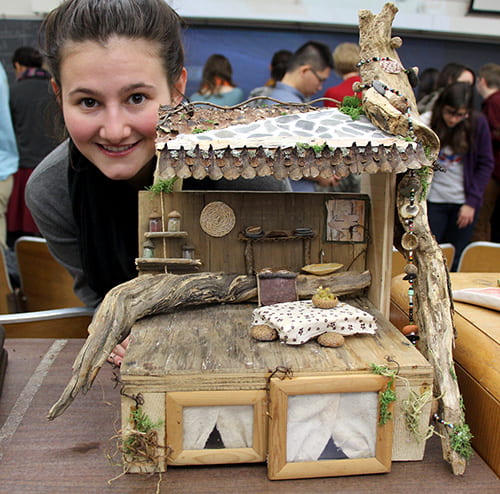

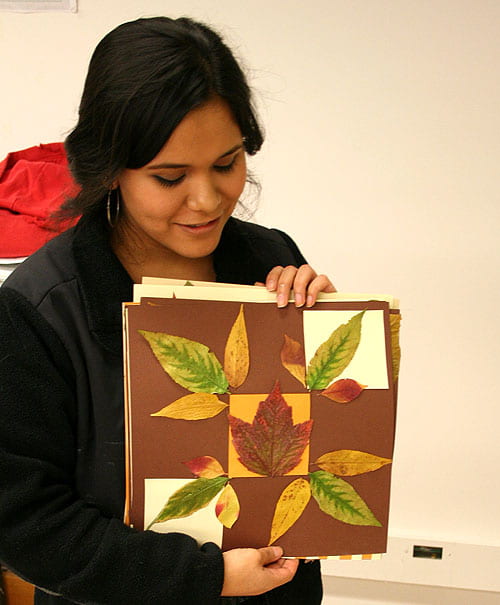
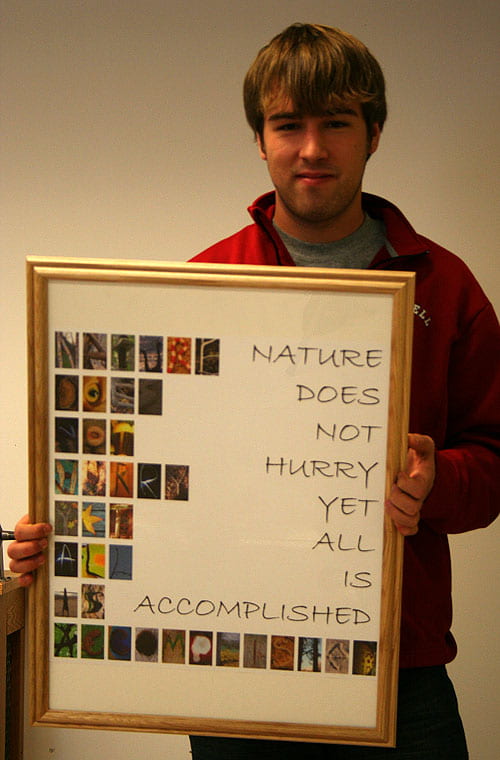
Toolkit
Our Dig Art! toolkits include a welcome letter, a full color poster, and eight beautifully illustrated activity cards. Specifically designed to inspire an interest in and enthusiasm for art projects in the garden, the toolkit offers a starting point for engaging in garden arts activities.
Feel free to download and print these materials on your own, and to share them with friends.
Activity Cards:
Leaf Print Casting front and back
Growing an Art Garden front and back
Basket Weaving front and back
Mosaic Making front and back
Gourd Band front and back
Jewelry Making front and back
Clothes Dyeing front and back
Painting and Photography front and back
Project Acknowledgments
Dig Art! is a collaborative effort. We are thankful for the support and expertise of many individuals and organizations.
Christine Hadekel, Project Creator
Marcia Eames-Sheavly, Project Advisor
Shira Golding, Poster Design & Illustration
Angela McGregor, Website
Activity Pilot Sites
Hort 1102: Hands-on Horticulture students and Professor Marvin Pritts (2007 & 2008)
Hort 2010: Art of Horticulture students and Professor Marcia Eames-Sheavly (2007 & 2008)
Art Garden
Aurora Ulbing
Tompkins-Seneca-Tioga BOCES New Visions (Board of Cooperative Educational Services)
Grass Photo Project
Howard Raskin
Frank Rossi
Craig Cramer
Sarah Richards-Desai
Cornell Council for the Arts
Gourd Crafting
Raylene Ludgate
Cornell Botanic Gardens
Mosaic Making
Students from STARR 07 (State Teen Action Rep Retreat, 4-H)
Joanne Baldini
top


